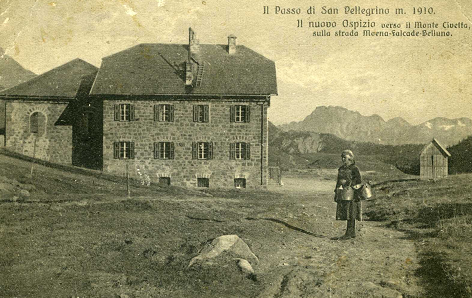|
(Randy was on a writing burst so I am including this. GV.)
By Randolph Fiery Geneva’s father, Robert Martin Zando, on the left in the photo of the three brothers, was an Italian stonemason and builder from Falcade, Italy. I think he first came through Ellis Island in 1910. He had built a large stone home in the Dolomites, not very far from the Austrian border. He was saving money to bring my grandmother, Caterina, and my uncles and aunt, Sixtus, Abraham and Mary to America, when World War I broke out. The Germans turned their large stone house into an officer’s home and office. My grandmother and the children lived in the attic and cooked, cleaned and were in essence servants to the German officers. My uncle Sixtus was a teenager, and they put him in a work camp. Because of the war, my grandfather was unable to bring grandmother and the kids to America until 1920. They settled in West Virginia because there was a need for stone workers to build structures for the mining industry. My grandfather was one of the first men building the beautiful stone bridges on the Skyline Drive and Blue Ridge Parkway. He also built a building – now in the national historic register -- made of coal in Williamson, West Virginia. My mother was the first of the family born in America and in 1940 or 1941 she was able to enter West Virginia University and receive a degree in biology. But I have an even better story, her older brother, Sixtus was a teenager when my grandmother and the three kids arrived at Ellis Island. Sixtus had a damaged leg and the officials at Ellis island labeled him a “cripple.” They were going to let my grandmother and two of the children enter America, but they did not want to let that “cripple boy” come in. My mom told me, that her mother and her siblings waited for days, if not weeks trying to get Sixtus allowed to enter America. She said her brother was prepared to go back to Italy and live with the family, but they somehow got the officials to finally let him in. They moved to the coalfields of southern West Virginia because there was lots of stonework to support the coal industry. Sixtus was a teenager with a damaged leg and they placed him in a first grade classroom to learn English. That young “crippled boy” did OK. He ended up graduating from medical school at Loyola University in Chicago. He had the money to pay for my mom going to college. Another side story: during my mom‘s senior year in high school, she won an academic scholarship to a small college in West Virginia. When they found out she was Catholic, they took away the scholarship. She worked for a year, and then her brother paid for her to go to school. She was the best human I have ever known.
Hillel Kuttler
8/30/2023 12:23:34 pm
I lived for many years in Washington and Baltimore, so I enjoyed many pleasant afternoons in Virginia’s Shenandoah Valley. I would drive on the Blue Ridge Parkway and Skyline Drive. Everyone in the D.C. area would do this on a weekend. We enjoyed the views, the small towns, the mountains, the farms, the winding roads and, especially, the glorious colors of the leaves in autumn. I well remember the stone work on the shoulders of the roads and on overpasses. And now, thanks to George, I know something of one of the people, Robert Zando, whose craftsmanship I admired.
GV
8/30/2023 01:45:53 pm
Hillel, thanks for the nice comment. I drive the Blue Ridge Parkway only once, ducking the rather pleasant I-81 on our drive to visit family in Atlanta. I was touched by the vistas and also the craft on the parkway -- not sure I knew what I was seeing. I've been an e-pal of Randy for years but never knew his family trade until I casually mentioned aj ourno friend of mine who has bought the farm -- in the good way -- south of Charlottesville. Randy, further south, volunteered that his father and other rellies had helped build bridges in my friend's new county. Hope all is well with you. GV
Hillel Kuttler
8/31/2023 02:51:01 am
George, I’m always fascinated by how connections are made and information gets out. Your friend buying land, then, also inadvertently is responsible for my (and your other readers) learning of the stone work on the Virginia byways. Even this tidbit has enriched us.
Randolph
8/31/2023 07:09:12 am
Hillel, 9/1/2023 02:48:09 pm
I'm a native New Yorker who was bon in Manhattan. My unprofessional observation is that people mean Manhattan when they say that they are from NY. Otherwise, they usually refer to the borough that they are from. 9/5/2023 10:30:11 am
Interesting story of an old world stone cutter. We usually think of European and other foreign countries who have been building and renovating cathedrals over the centuries. However, we need only to look in our own backyard at The Cathedral Church of St. John the Devine at 1047 Amsterdam Avenue at about 112th Street. Comments are closed.
|
Categories
All
|










